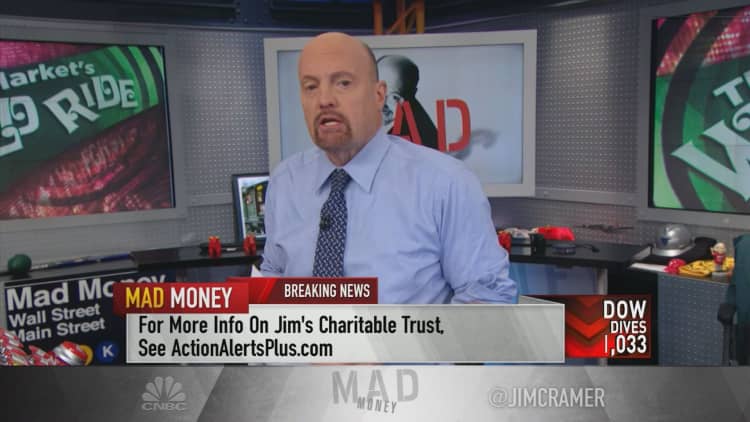
Many market-watchers have been wondering what caused this week's rapid-fire sell-off, so CNBC's Jim Cramer decided to oust the "real culprits" behind the nosedive.
"There are four instruments ... that I am watching to figure out when this portion of stock market nightmare is over," the "Mad Money" host said. "They're all a mouthful, but you know what? I owe you the whole truth and nothing but the truth, even if you actually need a rocket scientist to figure some of this out."
Cramer began by explaining the idea behind the CBOE Volatility Index, or VIX, colloquially known as the market's "fear gauge."
Volatility, most commonly tracked by the VIX, refers to the amount of uncertainty in the size and direction of changes in the stock market. It is typically measured by the deviation of returns.
For much of 2017, the VIX remained at extremely low levels. Its placid nature piqued Wall Street's interest, leading to the rise of leveraged trading vehicles like the XIV, the VelocityShares Daily Inverse VIX Short-Term exchange-traded note, as ways to short the low-volatility layout.
"Now, it isn't enough sometimes on Wall Street to just own volatility or bet against volatility," Cramer said. "Brokerages know people crave real juice, particularly hedge fund managers, so they invented stocks that allowed you to get twice the gain of the VIX on a given day, or get twice the loss of the VIX if it goes down on a given day," Cramer said.
"These instruments are the proximate cause of the madness you are now seeing," the "Mad Money" host said, pointing to four specific funds exacerbating the pain.
The first was the ProShares Ultra VIX Short-Term Futures ETF, an exchange-traded fund that tries to double the performance of the S&P 500 VIX Short-Term Futures Index every day.
With over 110 million shares traded on Thursday, this culprit was probably the subject of plenty of hedge fund managers' short positions because of last year's low volatility, Cramer said.
"Not anymore. There are some very big funds that have bet against this thing and they have to raise cash to stay short it. They can either end the pain and buy it back, or cover their call shorts, or they can just keep wagering by putting more and more of their money" by selling stocks or selling S&P futures to raise money, Cramer explained.
"I know it sounds difficult to believe, but managers actually considered this the trade for ages because they simply didn't believe that the VIX would or could spike as fast as it did. They just plain got caught plain out of position," he continued.
The second was the iPath S&P 500 VIX Short-Term Futures ETN, a Barclays Bank exchange-traded note that also bets on VIX futures going higher.
"[On Thursday], this fund started at $45 and it went to $55," Cramer said. "You would've made $10 on this one, but forget about that. If you had borrowed money and bet against it, you would have lost $10 that you didn't have to begin with. That is a huge percentage hit to your capital if you're running a fund. Once again, it sounds like something that couldn't really hurt the entire market, but how about this: nearly 85 million shares traded hands. That's called impact."
The third culprit was another exchange-traded note, the VelocityShares Daily 2X VIX Short-Term ETN, which gives traders twice the daily return of the S&P 500 VIX Short-Term Futures index.
"Can you believe the SEC blessed this junk?" Cramer asked. "Today the TVIX started at 9 and went to 13.5. That's a huge gain — or a huge loss of you bet against it — too big for most funds to sustain. So what do they do? They have to sell something to raise capital to pay off their losing wager, so they sold off your stocks. [The] TVIX ... traded 112 million shares today, for heaven's sake. That is insane."
The fourth cause of the decline was the ProShares VIX Short-Term Futures ETF, yet another trading instrument that correlates to the inverse of S&P 500 VIX futures.
"This one goes down if the VIX spikes as it did today," Cramer said. "If you owned it, you got annihilated. If you shorted it, you did well. The people who owned it are the real problem because they lost a huge amount of money, probably borrowed money, and if they did indeed borrow the money they will have to put up a huge amount of collateral tomorrow. Forty-three million shares traded hands today."
There are at least 12 other trading instruments like these, but Cramer wanted to review the ones with the most volume so investors knew what was leading the pressure on the market.
"Now, we don't know when all of this tail-wagging-the-dog will end, ... but if you follow the UVXY, the VXX, the TVIX and the SVXY and you see the volume dry up on these, ... that will mean that their power to overwhelm will diminish," Cramer concluded. "It doesn't mean the stock market will automatically go up when that happens. ... It does mean the coast is a lot clearer than it is now."
WATCH: Cramer on the 4 VIX-related securities causing market madness

Questions for Cramer?
Call Cramer: 1-800-743-CNBC
Want to take a deep dive into Cramer's world? Hit him up!
Mad Money Twitter - Jim Cramer Twitter - Facebook - Instagram - Vine
Questions, comments, suggestions for the "Mad Money" website? madcap@cnbc.com



